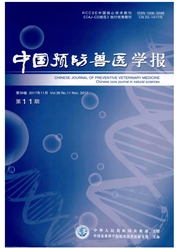

 中文摘要:
中文摘要:
伪狂犬病毒(PRV)能够感染神经元细胞并且跨突触传播,该特性使它成为了一种新兴的神经示踪病毒。为探究PRV在动物体内分布情况,本研究构建了PRV人工感染大鼠模型,通过免疫组化技术检测了PRV在大鼠体内各组织器官中的增殖分布情况,同时还将免疫组化检测结果与PCR检测结果相比较。结果表明利用免疫组化技术分别在PRV感染72 h、78 h、84 h、96 h、104 h、108 h后开始依次在大鼠的脑、肺、肾、脾、肝、心检测到PRV。同时在总计36个PRV检测样品中,PCR检测的检出率为50%,免疫组化检测的检出率为36%,两者的符合率为72%。本研究利用免疫组化技术观察PRV感染大鼠后在体内增殖分布规律和病变程度,为进一步探索RV的组织嗜性以及机体抗病毒作用机制奠定基础。
 英文摘要:
英文摘要:
Pseudorabies virus (PRV) has the ability to infect neuronal cells and synaptic transmission, which could be applied as a kind of new tracer for neuronal cell studies. To determinate the PRV distribution in artificially infected mouse, we established a PRV-infected rat model to analyze the viral distributionin infected animals. The distribution of PRV in various tissues of infected rats was detected by immunehistochemistry (IHC) assay and was compared with the conventional PCR.The results showed that the brain, lung, spleen and kidney of infected rats could be detected by 1HC assay at 72, 78, 84, 96, 104, 108 hrs post infection. And the detected rates were 50% by PCR and 36% by IHC, respectively, and the coincidence rate of the two assays was 72%. This study provided a basis for further study on the characteristics of PRV and antiviral mechanism of the host.
 同期刊论文项目
同期刊论文项目
 同项目期刊论文
同项目期刊论文
 期刊信息
期刊信息
